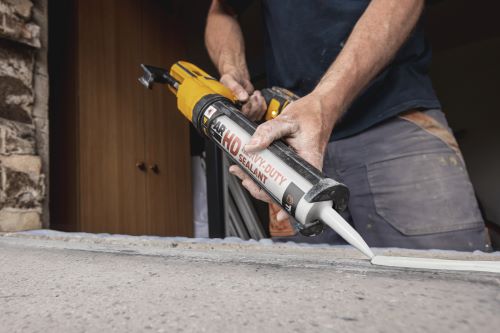
If you want to ensure your next project is energy efficient and stands the test of time, you need a high-performance building envelope. While a lot of attention gets paid to selecting components like building wrap, insulation, and cladding, one critical element you can’t afford to overlook is the type of sealant you’re using around doors, windows, and other seams in the building envelope.
Selecting the right sealant is important in determining how effectively your building can hold out unwanted air and moisture. Not all sealants are created equal, of course. There are many unique sealant products and formulations out there, each with its own performance benefits and drawbacks. Compatibility with the rest of your building envelope components should play a major part in your selection process, too. No matter how great a particular sealant claims to be, if it doesn’t create strong adhesion to your other specified materials, it’s not right for your project.
We understand the complexities of choosing a sealant, which is why we developed TYPAR Heavy-Duty Sealant. The latest addition to our TYPAR Weather Protection System, our Heavy-Duty Sealant was custom engineered for compatibility with the complete line of TYPAR building wraps—taking the guesswork out of choosing the best sealant to use with our weather protection products.
But before we expand on the performance benefits of our new Heavy-Duty Sealant, it’s important to understand the three primary sealant technologies on the market today:
Polyurethane sealants have gained popularity for their exceptional resilience and flexibility. These sealants form a robust bond with various substrates, including wood and plywood, and are known for their resistance to weathering, ultraviolet (UV) light, chemicals, and abrasion. However, their relatively slow curing time can be a drawback in some construction scenarios, and polyurethane sealants also have the potential to become brittle in colder temperatures, which would negatively impact flexibility in the joint.
Relative to polyurethane, silicone sealants are better able to withstand temperature changes and are better suited to colder applications, maintaining their flexibility over a wider temperature range. Silicone sealants have fast drying/cure times and are highly water resistant, making them good for plumbing applications. However, silicone sealants do not adhere well to certain surfaces common in exterior construction, such as wood, and they can be challenging to paint over.
Acrylic sealants are known for their high bonding strength, which can be achieved on a wide range of substrates with minimal surface preparation. They can be installed in a range of temperatures without compromising performance and offer long-term UV stability. However, acrylic sealants may lack the durability and flexibility needed for external applications, and these types of products are more typically used for interior projects like tile and bath installation. When working with acrylics, installers need to be mindful of surface moisture, as any moisture on the substrate can negatively impact adhesion. These types of sealants also require a two-part curing process.
As you can see, each type of sealant technology offers potential strengths and weaknesses depending on its intended use. The latest innovations in construction sealants combine the benefits of each, creating unique hybrid compositions that can provide superior performance while limiting the potential drawbacks.
A prime example of this trend is the rise of STP/SMP sealants, which combine the best characteristics of polyurethane and silicone. These sealants offer excellent adhesion to a wide variety of substrates, are easy to apply at low temperatures and maintain their flexibility and adhesion across a wide range of temperatures. The biggest drawbacks to these types of products are that they take longer to cure and often come at a higher price point.
At the cutting edge of building envelope sealant innovation are products are modified urethane acrylics. Our new Heavy-Duty Sealant is a custom-engineered modified urethane acrylic, which is a fancy way of saying it is versatile, easy to install, and provides superior adhesion in a wide range of temperatures and project conditions. We decided to go with a modified urethane acrylic for our Heavy-Duty Sealant because it draws on the strengths of both polyurethanes and acrylics to deliver a range of performance characteristics ideal for creating air- and water-tight building envelopes.
TYPAR Heavy-Duty Sealant handles and spreads easily, with gunnability down to 40°F (4°C), ensuring project timelines remain unaffected by cold weather conditions. It is easy to tool for fast applications and neater joints, making installation efficient.
Speaking of joints, TYPAR Heavy-Duty Sealant seals joints up to 2” with proper installation and joint design, leading the industry in this aspect and accommodating various construction requirements. It fully cures within 48-72 hours, with a tack-free time of 60 minutes, expediting construction timelines. And like all TYPAR products, TYPAR Heavy-Duty Sealant can be counted on for rugged performance, with tensile strength exceeding 150 psi, as tested in accordance with ASTM D2370, guaranteeing structural integrity.
The modified urethane acrylic composition is paintable and stain-resistant, allowing for customization and maintaining a polished appearance. It’s also low VOC at less than 1.5%, meeting all 50 U.S. states’ VOC requirements.
Most importantly, TYPAR’s unique modified urethane acrylic sealant was developed and tested to form a strong bond with TYPAR’s spun-bonded polypropylene building wraps for optimal system compatibility.
As the construction industry continues to evolve, choosing the right sealant becomes more important than ever for achieving resilient and sustainable building envelopes. The emergence of hybrid sealant technologies, exemplified by TYPAR's Heavy-Duty Sealant, showcases the industry's commitment to innovation and efficiency—and the performance benefits they can offer on the job site. By understanding the pros and cons of various sealant technologies, you can make better informed decisions on which will deliver the results you’re looking for.